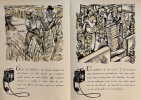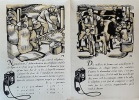[Poème-affiche] BOESCH Paul :
Le téléphone *
Sans nom ni lieu ni date ni rien. Affiche publicitaire polychrome 42 30, pliée en quatre (comme moi pour répondre la bonne parole au top du bibliotope) imprimée recto-verso. En très bel état de conservation. Cinq motifs gravés sur le bois de Paul Boesch, donc quatre bicolores avec texte au verso.
Reference : YG19998
Plus que probablement imprimé chez ROTH et SAUTER. > En cas de problème de commande, veuillez nous contacter par notre page d'accueil / If you have any problems with your order please contact us via our homepage <
Bookseller's contact details
Librairie Oh 7e Ciel
M. Yves Gindrat
Rue de l'Académie 4
1005 Lausanne
Switzerland
Payment mode
Sale conditions
Paiement par virement bancaire en francs suisses ou en euros. Les livres sont envoyés dans les jours suivants l'encaissement.
5 book(s) with the same title
Transatlantic Communications. TAT-1. - [FIRST DESCRIPTION OF THE FIRST SUBMARINE TRANSATLANTIC TELEPHONE CABLE SYSTEM, TAT-1]
New York, American Telephone and Telegraph Company, 1957. 8vo. Original full green cloth, bound with the original blue wrappers. Volume 36, 1957 of ""The Bell System Technical Journal"". Library stamp to pasted down front free end-paper. Minor bumping to extremities. A nice and clean copy. [Entire issue:] 20, 1513 pp.
First edition of the first technical description of the TAT-1, the first submarine transatlantic telephone cable system. The 2,240-mile cable was laid by the cableship Monarch and ran from Gallanach Bay, near Oban in Argyll, to Clarenville, Canada. The initial capacity was 36 calls at a time at a price per call of $12 for the first three minutes. Since trans-Atlantic service opened in 1927, calls had traveled across the ocean via radio waves. But cables provide much higher signal quality, avoid atmospheric interference and offer greater capacity and security.""The papers that follow describe the design, manufacture and installation of the first transatlantic telephone cable system with all its component parts, including the connection microwave radio-relay system in Nova Scotia."" (From the introduction to the present papers).""Years of development led up to 1956 when the first transatlantic telephone cable system started carrying calls"" this is an interesting story in itself. Two coaxial cables about 20 miles apart carried 36 two-way circuits. Nearly 50 sophisticated repeaters were spaced from 10 to 40 miles along the way. Each vacuum tube repeater contained 5,000 parts and cost almost $100,000."" (Petruzzellis, Thomas. Telephone Projects for the Evil Genius, 2008, p. 4). The electronic repeaters, the devices that held together the many separate cables, were designed by the Bell Telephone Laboratories. In terms of reliable operation, the most critical component of the system was the repeater. These devices, spaced at intervals of 37.5 nautical miles along the cable, compensated for loss. The repeaters were of a unique flexible design, which allowed them to be handled in the same manner as cable.TAT-1 carried the Moscow-Washington hotline between the American and Soviet heads of state.Other papers of interest contained in the present volume:1. Kelly, Dr. Mervin J." Radley, Sir Gordon. Transatlantic Communications - An Historical Resume. Pp. 1-5.2. Mottram, E.T. Halsey, R.J. Emling, J.W. Griffith, R.G. Transatlantic Telephone Cable System - Planning and Over-All Performance. Pp. 7-27.3. Lewis, H.A. Tucker, R.S. Lovell, G.H. Fraser, J. M. System Design for the North Atlantic Link. Pp. 29-68.4. Gleichmann, T.F. Lince, A.H. Wooley, M.C. Braga, F.J. Repeater Design for the North Atlantic Link. Pp. 69-101. 5. Lamb, H.A. Heffner, W.W. Repeater Production for the North Atlantic Link. Pp. 103-138. 6. Meszaros, G.W. Spencer, H.H. Power Feed Equipment for the North Atlantic Link. Pp. 139-162.7. McNally, J.O. Metson, G.H. Veazie, E.A. Holmes, M.F. Electron Tubes for the Transatlantic Cable System. Pp. 163-188.8. Lebert, A.W. Fischer, H.B. Biskeborn, M.C. Cable Design and Manufacture for the Transatlantic Submarine Cable System. Pp. 189-216.9. Halsey, R.J. Bampton, J.F. System Design for the Newfoundland-Nova Scotia Link. Pp. 217-244.10. Brockbank, R.A. Walker, D.C. Welsby, V.G. Repeater Design for the Newfoundland-Nova Scotia Link. Pp. 245-276.11. Thomas, J.F.P. Kelly, R. Power-Feed System for the Newfoundland-Nova Scotia Link. Pp. 277-292.12. Jack, J.S. Leech, Capt. W.H. Lewis, H.A. Route Selection and Cable Laying for the Transatlantic Cable System. Pp. 293-326.And many other.
Transatlantic Communications. [11 papers, see below]. - [FIRST DESCRIPTION OF THE FIRST SUBMARINE TRANSATLANTIC TELEPHONE CABLE SYSTEM, TAT-1]
New York, American Telephone and Telegraph Company, 1957. 8vo. Volume 36, 1957 of ""The Bell System Technical Journal"". In the original printed blue wrappers. Sunning to spine, and very minor spotting to wrappers. Internally near mint. 348 pp.
First edition of the first technical description of the TAT-1, the first submarine transatlantic telephone cable system. The 2,240-mile cable was laid by the cableship Monarch and ran from Gallanach Bay, near Oban in Argyll, to Clarenville, Canada.""The papers that follow describe the design, manufacture and installation of the first transatlantic telephone cable system with all its component parts, including the connection microwave radio-relay system in Nova Scotia."" (From the introduction to the present volume).""Years of development led up to 1956 when the first transatlantic telephone cable system started carrying calls"" this is an interesting story in itself. Two coaxial cables about 20 miles apart carried 36 two-way circuits. Nearly 50 sophisticated repeaters were spaced from 10 to 40 miles along the way. Each vacuum tube repeater contained 5,000 parts and cost almost $100,000."" (Petruzzellis, Thomas. Telephone Projects for the Evil Genius, 2008, p. 4). The electronic repeaters, the devices that held together the many separate cables, were designed by the Bell Telephone Laboratories. In terms of reliable operation, the most critical component of the system was the repeater. These devices, spaced at intervals of 37.5 nautical miles along the cable, compensated for loss. The repeaters were of a unique flexible design, which allowed them to be handled in the same manner as cable.TAT-1 carried the Moscow-Washington hotline between the American and Soviet heads of state.Other papers of interest contained in the present volume:1. Kelly, Dr. Mervin J." Radley, Sir Gordon. Transatlantic Communications - An Historical Resume. Pp. 1-5.2. Mottram, E.T. Halsey, R.J. Emling, J.W. Griffith, R.G. Transatlantic Telephone Cable System - Planning and Over-All Performance. Pp. 7-27.3. Lewis, H.A. Tucker, R.S. Lovell, G.H. Fraser, J. M. System Design for the North Atlantic Link. Pp. 29-68.4. Gleichmann, T.F. Lince, A.H. Wooley, M.C. Braga, F.J. Repeater Design for the North Atlantic Link. Pp. 69-101. 5. Lamb, H.A. Heffner, W.W. Repeater Production for the North Atlantic Link. Pp. 103-138. 6. Meszaros, G.W. Spencer, H.H. Power Feed Equipment for the North Atlantic Link. Pp. 139-162.7. McNally, J.O. Metson, G.H. Veazie, E.A. Holmes, M.F. Electron Tubes for the Transatlantic Cable System. Pp. 163-188.8. Lebert, A.W. Fischer, H.B. Biskeborn, M.C. Cable Design and Manufacture for the Transatlantic Submarine Cable System. Pp. 189-216.9. Halsey, R.J. Bampton, J.F. System Design for the Newfoundland-Nova Scotia Link. Pp. 217-244.10. Brockbank, R.A. Walker, D.C. Welsby, V.G. Repeater Design for the Newfoundland-Nova Scotia Link. Pp. 245-276.11. Thomas, J.F.P. Kelly, R. Power-Feed System for the Newfoundland-Nova Scotia Link. Pp. 277-292.12. Jack, J.S. Leech, Capt. W.H. Lewis, H.A. Route Selection and Cable Laying for the Transatlantic Cable System. Pp. 293-326.
FOLKLORE DE CHAMPAGNE N°120-121 / N° spécial double 3e trimestre 1990 : Le Téléphone en ligne avec son temps.
Méry-sur-Seine : Revue des Arts et Traditions populaires de la Région Champagne-Ardenne / Société des Amateurs de Folklore et Arts Champenois (SAFAC), 1990. Revue 29,5x21cm, couverture couleur, 70 pages illustrées de documents en noir.
Le téléphone en ligne avec son temps / Le télégraphe optique Chappe / Le téléphone électrique Baudot / Le réseau, le central / Télécommunications hertziennes / Le centre de Bercenay-en-Othe / La Grève de 1909 / La femme et le téléphone / Mémoires et souvenirs / Télécom An 2000...
Le téléphone à la belle époque - de la fée éléctricité au téléphone, l'invention du téléphone, l'idée de Bourseul, l'appareil réversible de Bell, l'essor du téléphone dans le monde...
Libro-sciences SPRL. 1976. In-4. Broché. Etat d'usage, Couv. convenable, Dos satisfaisant, Intérieur frais. 142 pages. Nombeuses gravures en noir et blanc, dans et hors texte. Annotation sur le premier contreplat.. . . . Classification Dewey : 621.382-Télécommunications
de la fée éléctricité au téléphone, l'invention du téléphone, l'idée de Bourseul, l'appareil réversible de Bell, l'essor du téléphone dans le monde.... Classification Dewey : 621.382-Télécommunications
Application of the Theory of Probability To Telephone Trunking Problems. - [SEMINAL CONTRIBUTIONS TO TELEPHONE TRAFFIC THEORY]
New York, American Telephone and Telegraph Company, 1927. Lex8vo. Volume VI, July, No. 3, 1927 of ""The Bell System Technical Journal"". In the original printed blue wrappers. A bit of browning to spine and extremities, but overall fine. Internally very nice and clean. Pp. 461-494. [Entire issue: Pp. 375-550].
First publication of Molina's fundamental discussion on the problems concerning telephone trunking problems. ""If telephone plants were provided in such quantities that when a subscriber makes a call there would be immediately available such switching arrangements and such trunks or paths to the desired point as may be necessary to establish the connection instantly, it would require that path and switching facilities be provided to meet the maximum demand occurring at any time, with the result that there would be a large amount of plant not in use most of the time."" (From the introduction to the present paper).""Edward C. Molina, a self-taught researcher, made seminal contributions to telephone traffic theory. [...] There were early attempts to use probability theory for the analysis of exchange"" (Gass, An annotated timeline of operations research, 2005, p. 35.). His 1928 book on congestion theory became the classic text on the subject. The present paper anticipates many of the themes and problems presented in that book.Other papers of interest contained in the present issue:1. Ferguson, J.G. Measurement of Inductance by the Shielded Owen Bridge. Pp. 375-386.2. Gilbert, J.J. Determination of Electrical Characteristics of Loaded Telegraph Cables. Pp. 387-401.3. Clokey, A.A. Automatic Printing Equipment for Long Loaded Submarine Telegraph Cables. Pp. 402-424.4. Curtis, Austen M. The Application of Vacuum Tube Amplifiers to Submarine Telegraph Cables. Pp. 425-441.5. Peterson, Eugene" Evans, Herbert P.Modulation in Vacuum Tubes Used As Amplifiers. Pp. 442-460.6. Carson, John R. Hoyt, Ray S.Propagation of Periodic Currents Over a System Of Parallel Wires. Pp. 495-545.
 Write to the booksellers
Write to the booksellers





